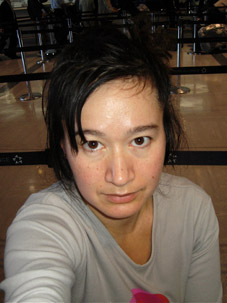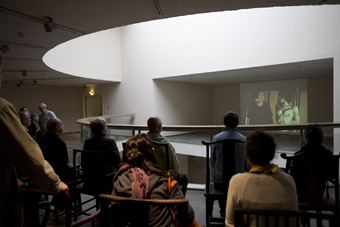making films politically
zanny begg on the films of hito steyerl

Hito Steyerl
photo courtesy of the artist
Hito Steyerl
IN THIS YEAR’S DOCUMENTA IN KASSEL, GERMANY, HITO STEYERL SHOWED THREE WORKS: JOURNAL NO 1—AN ARTIST’S IMPRESSION; LOVELY ANDREA; AND RED ALERT. THESE REVEAL THE IMPORTANT CONTRIBUTION THAT STEYERL, A GERMAN BASED ARTIST OF JAPANESE HERITAGE, IS MAKING TO FILM PRODUCTION WITHIN A CONTEMPORARY ART CONTEXT.
Artistic film, as opposed to video installation, sits uneasily in the exhibition framework. While video installations often have a rhizomatic structure, viewed as easily in the beginning, middle or end, the more linear time structure of film, which requires a viewer to be present at the beginning and stay at least for most of the film, has presented some exhibition challenges. This year the artistic director of Documenta 12, Roger Beurgel, claimed to have solved the problem by returning film to the cinema, offering an extensive program in conjunction with the main exhibition.
Steyerl’s innovative and challenging work has ensured its being primarily viewed within an art rather than a cinema context. Even in Documenta 12 her two longest video works were exhibited as projections in the key exhibition venues. Steyerl’s work stood out as unique given the marked decline in film work as a whole between Documenta 11 and 12, especially for the form of film Steyerl has been most interested in—documentary. In an interview with her in Berlin in June this year, she explained to me, “there has been a tremendous, conservative backlash in parts of the art world aimed at socially engaged art, which was subsumed under the derogatory identifier ‘documentary’ as opposed to ‘art’.”
Steyerl is quick to point out that mainstream documentaries should not be discussed as ‘art’, unless there is experimentation or formal contestation of the form of documentary making. She remains interested in works which challenge our preconceptions of what a documentary should do. Her own works have consistently explored ideas such as the relationship between fiction and truth, viewer, subject and filmmaker, and the subjective and objective within the documentary cannon. As she explained in a recent article “Documentary Uncertainty”, “terms like ‘truth’, ‘reality’ and ‘objectivity’ and so on are characterized by the lack of any generally valid interpretation and of any clear cut definitions. Thus we are faced with the first paradox: the documentary form which is supposed to transmit knowledge in a transparent and clear way has to be investigated using conceptual tools which are neither clear nor transparent.”
Journal No. 1—An Artist’s Impression deliberately explores this very paradox. Journal No 1 was the title of the first monthly Bosnian newsreel made in 1947 which was lost in 1993 during the Yugoslav war. This newsreel shows, among other things, images of Muslim women learning to read and write in the secular post-war Yugoslavia under Josip Broz Tito. In her film, Steyerl attempts to reconstruct the newsreel by inviting two staff members from Film Museum Sarajevo to recount its contents to an artist, Arman Kulasic, who sketches their memories. The two accounts of the missing newsreel, however, differ both in the recollection of its contents and its eventual fate. Steyerl then attempts to find the missing film in a search across the new post-war Croatia.
Steyerl eventually finds the newsreel in a house it was taken to for safe storage. But it was burnt in the war, its charred condition rendering it unwatchable: the ‘truth’ of the accounts of this newsreel thus remaining forever unverifiable. The film ends with the artist Arman Kulasic explaining his own experiences of ethnic cleansing during the war and his difficulties in getting a visa to travel to the USA after 9/11 because of his Muslim background. Steyerl’s detective-like search for truth thus ends up creating as many questions on the nature of documentary making as it does on the Yugoslav war and war more broadly.
But while Steyerl is interested in exploring the murky relationship between the representation of fact and fiction in documentaries she is not interested in abandoning the quest for truth altogether. She explains that truth, “as constructed or artificial as it might be”, is the “precondition of any political sphere which deserves this name.” She goes on to say that “as Hannah Arendt pointed out truth is indispensable in political terms. Arendt didn’t mean absolute truth, but simply an agreement about material facts. If this is jeopardised then we have a huge political problem.” So while Journal No. 1—An Artist’s Impression may complicate our preconceived ideas about the Yugoslav war and historical and contemporary documentary making, it does not give up on the idea of understanding and truth as being crucial for political reconciliation and justice.
In an interview about his 1972 film with Jean-Pierre Gorin, Tout Va Bien, Jean-Luc Godard commented that the task for filmmakers, or artists more broadly, is not to make “political films” but to “make film politically.” Hito Steyerl’s films are undeniably “political”—covering subjects such as racism, war and terrorism—but what makes them so interesting is her attempts to construct them politically, to unpick and explore her own position within the framework of filmmaking.
This was very apparent in her 2004 film, November, which was screened in Australia as part of the If You See Something, Say Something exhibition (co-curated by Keg de Souza and myself) at Gallery 4a in January 2007 (RT78, p46). Here she combines old footage she shot as a teenager with her friend Andrea with a contemporary documentary about Andrea’s later involvement as a freedom fighter during the war in Kurdistan, and her eventual murder. The juxtaposition of the earlier feminist action movie—the teenagers create a gang of female outlaws who roam around intimidating men—with the footage of Andrea’s death creates a moving exploration of the transition from idealism and youthful political fantasy to reality. While Steyerl is obviously admiring of her friend she is careful not to posthumously create a heroine. The title November was chosen because of its position after October—the month of the Russian revolution—and describes a time of disillusionment and exhaustion after intense political struggle. In November Steyerl works through feelings of grief at her friend’s death as she seeks an understanding of the political factors which shaped her fate.

Hito Steyerl, Lovely Andrea, installation, Documenta 12
At Documenta 12, Steyerl loosely returns to her friend in the film Lovely Andrea (shown in the atrium of the Fridericianum). The title comes from a character, “Lovely Andrea”, Steyerl created as a tribute to her friend when the filmmaker herself posed for bondage photographs while in Japan in 1987. Lovely Andrea unfolds like a detective story as Steyerl returns 20 years later to Japan to locate the magazine which published these pictures—a quest, unlike the one for the Bosnian newsreel, in which she is ultimately successful.
Lovely Andrea is an extremely visually seductive and entertaining film. Steyerl focuses on the nawa-shibari style of bondage which involves the capture and suspension of women in the air by ropes. She explores this notion with a young Japanese aerial performer who acts as a quasi guide for Steyerl through the world of contemporary Japanese bondage. The film includes several shots of this woman suspended by ropes, performing various bondage scenarios and intercut with popular culture references including Spiderman, The Pet Shop Boys and Wonder Woman. The film moves like a detective thriller-visual interest sustained through the search and eventual discovery of the pictures.
When discussing the film Steyerl explains that her interest in bondage was not just about finding a missing piece of her own history but was an allegory for modern society. She draws on a 1930 text by Siegfried Kracauer, The Ornament of Mass, in which he described a performance by a group of showgirls, The Tiller Girls. Kracauer was fascinated by how the performers would move their legs as if they were being mass produced on an assembly line. Steyerl explains, “he made a point of choosing a humble, if not outright silly and over-commodified example from mass culture to interpret it as a reflex of the dominant conditions of production of this time: Taylorism. He understood that one shouldn’t complain about this type of culture, but move right through it. The total abstraction of disconnected limbs was not only a machine in the sense of an assembly line, but also presented a way beyond the fateful implications of the ‘natural body’, which became horribly explicit in National-Socialist race policies shortly after. It could not just be read as an allegory of economic bondage, but also the first announcement of its overcoming.”
According to Steyerl the link between this 1930s exploration of the body and her own work is that she sees the self-suspension performance, which the main protagonist of Lovely Andrea develops, in a similar way: “first of all, it is a reflex of an economical situation of self-entrepreneurship, in which we have internalised authority to a point to incorporate both ‘master and slave’ within the same individual. One motivates oneself, pushes oneself to work to the point of self-exploitation. But on the other hand this performance doesn’t stop at visualising this practice, but utilises the same tools that would normally be used for bondage and submission in order to create something completely different. Actually, this performance is much more about flying and floating, about overcoming gravity than about captivity and passivity. So this performance goes right through bondage into a different direction.”
Lovely Andrea is a very ambitious film—attempting to draw from Steyerl’s brief encounter with bondage many allegories about contemporary society. But the comic and at times literal way she does this—particularly her reliance on visual equivalence between the ropes of bondage and the internet as the modern web of life—can come across as a little forced. While Lovely Andrea loosely refers to Steyerl’s attachment to her friend Andrea it does this without the personal involvement which made November so powerful. In many ways it feels like Steyerl is shielding herself, a position at odds with the task the film set itself—the discovery of youthful bondage photographs of the artist. But the film is very clever and interesting if a little less resolved than Steyerl’s other work
Red Alert is a three screen red monochrome video representing an experiment by the artist in abstract video documentation and is a meditation on the 1921 painting of three monochrome canvases by Aleksandre Rodchenko, Pure Red Color, Pure Yellow Color, Pure Blue Color. Rodchenko wrote of these paintings, “I reduced painting to its logical conclusion and exhibited three canvases: red, blue and yellow. I affirmed: It’s all over. Basic colours. Every plane, it’s a plane and there is no more to representation.” Steyerl refers to this avant-garde gesture when she writes, “Red Alert translates this work into video, the assumption being that of these three primary colours only the red one is left. This red is actually based on the colour used by the US Homeland Security office for their highest alert level. It is, if you like, the colour of contemporary fear itself. On the other hand, this work also shows the limit of video, since the moving image has to be frozen in order to translate it into a painting format. And video or concrete representation of reality reaches its limit in the end of constant online transmissions which convey just abstract fear as such, with a minimum of concrete mediation.”
Two of Steyerl’s films, November and The Normality, were shown at the gerMANY FACES australia festival as part of the videokunst.de symposium curated by Anna Munster at the College of Fine Arts, Sydney, Sept 23.
RealTime issue #81 Oct-Nov 2007 pg. 25






